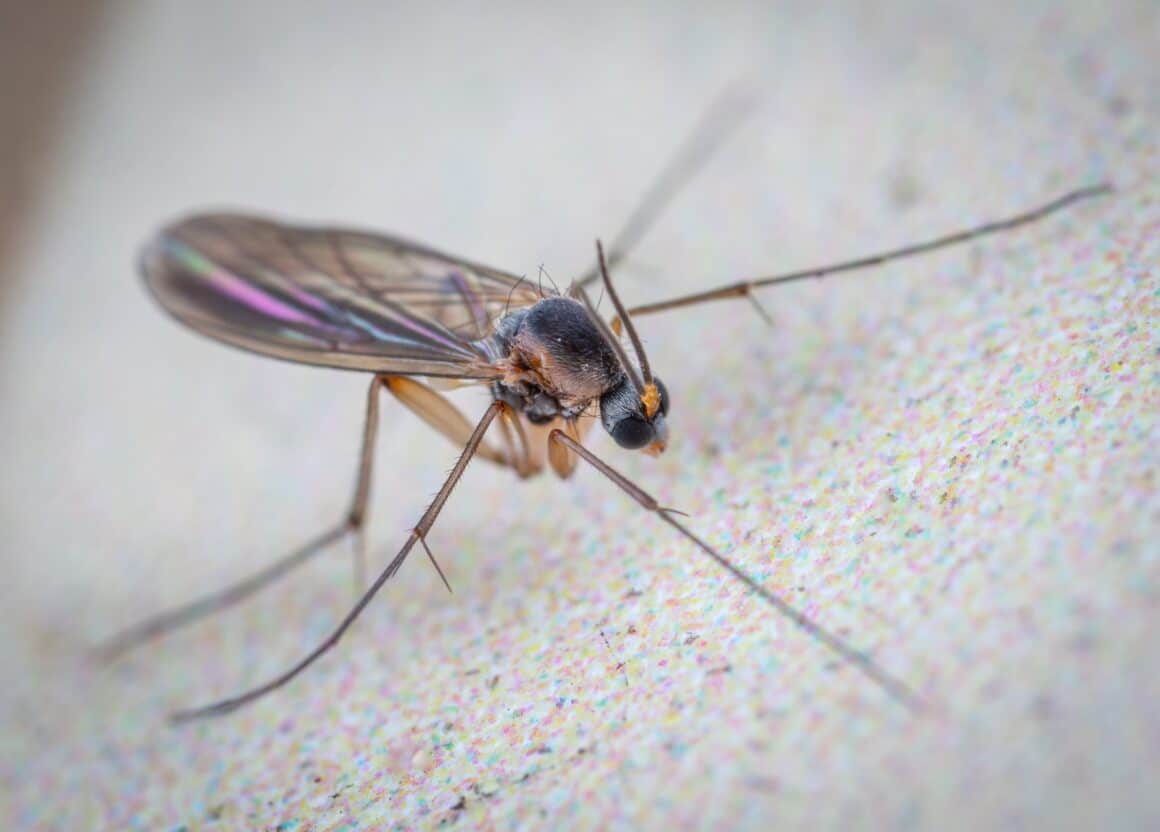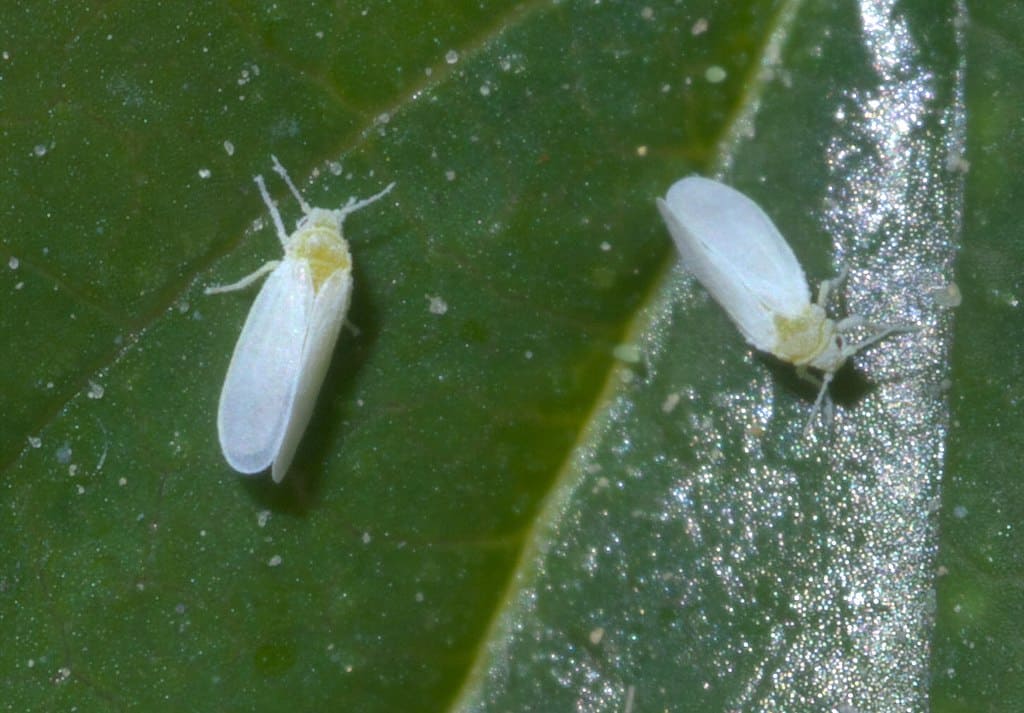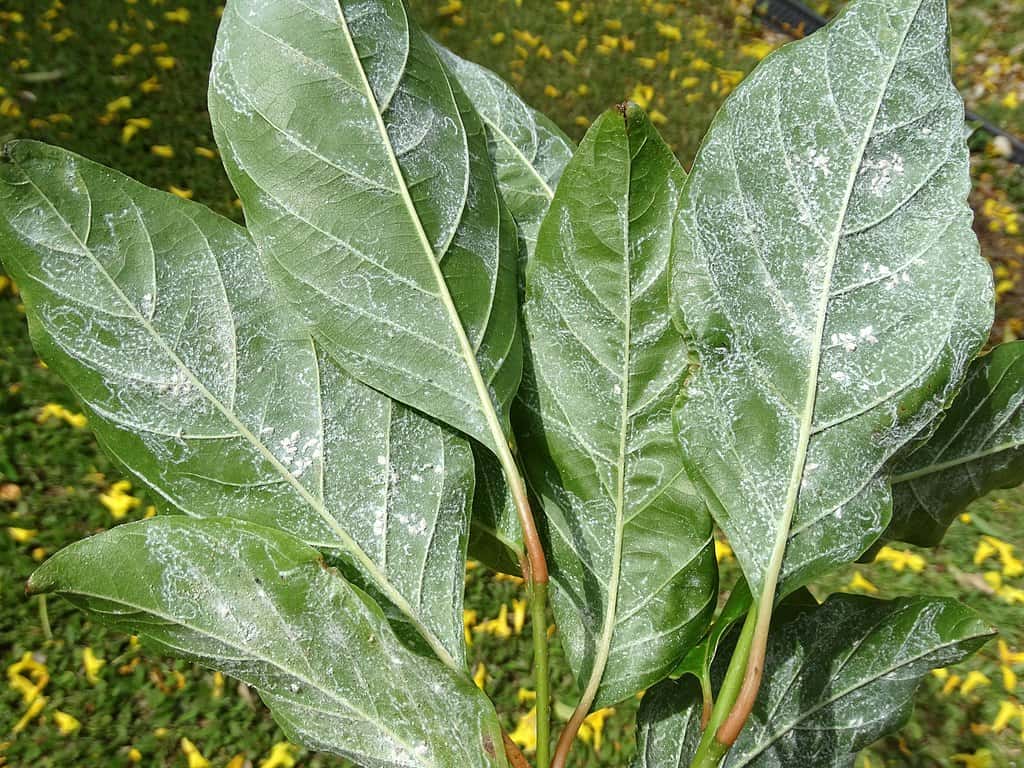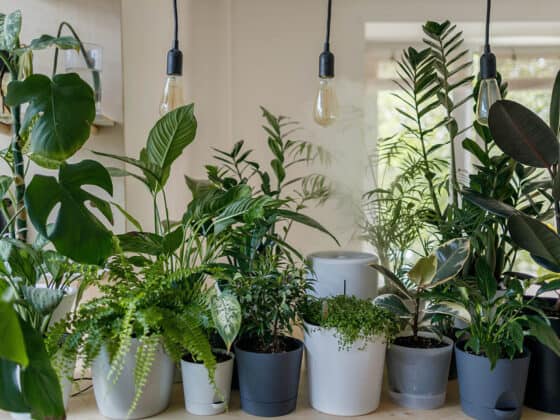As most plant enthusiasts already know, having to deal with some kind of flying pest on a houseplant is pretty much inevitable. Because of their mobility, many flies easily seek out our plants as a food source and breeding ground. Fighting them off is possible, but it definitely helps to know what kind of fly is attacking your plant in order to deploy the right kinds of treatments.
Some of the most common flying pests that infest houseplants are fungus gnats and whiteflies. Fungus gnats lay eggs in the soil, where larvae feed on organic material in the dirt. Whiteflies are moth-like insects that live on plants and feed on sap. Although commonly mistaken as plant pest, fruit flies aren’t actually a threat to houseplants.
Although discovering an infestation of flying insects on your houseplants can certainly be highly annoying, the good news is that there are ways to treat for them. The key is to properly identify the specific type of fly you are dealing with so you can target them with the right treatments.
In this article, we’ll cover how to identify whiteflies, fungus gnats, and fruit flies, as well as what you should do once you discover them living amongst your houseplants.
What Are the Tiny Flies Around My Houseplants?
As is common with many fly infestations, the first sign you’ll likely notice of them is the small swarm of adults that take flight any time you get near or disturb an infested houseplant. Usually, larvae are so small and inconspicuous that they go unnoticed for several weeks, but as soon as you start seeing flying adults, you’re undoubtedly dealing with a well-established infestation.
At this point, you can probably deduce that you either have a whitefly or fungus gnat infestation. There are plenty of other houseplant pests that have at least one winged stage of life, but insects like aphids or thrips tend to be weak fliers and don’t exhibit the hovering flight commonly seen by flies.
You’ll have to take a closer look to be sure, but there are very easy ways to tell exactly what type of fly you are dealing with that we will discuss below.
They’re Not Fruit Flies
What about fruit flies? Those annoying little gnats are very common indoors and tend to be everywhere you don’t want them to be.
While that may be true, fruit flies are not actually attracted to houseplants at all. Fruit flies are a different insect family that feeds on fruit and other sugary substances, including fermented sugars, like those that may be spilled from an alcoholic beverage.
They are very common in our homes, mainly because we tend to keep fruit and other food out on our counters and throw peels and scraps into trash cans, garbage disposals, or compost bins, where they happily feed on them.
Although it is possible you might find fruit flies near one of your houseplants, it isn’t because they are infesting the plant. They are likely just searching for something to feed on and giving the damp organic materials found in potting soil a try.
They also aren’t laying eggs in the soil. Fruit flies tend to lay eggs directly on or into decaying fruit or within dirty, slimy drains, which larvae can feed on upon hatching. Potting soil and plant material are not good food sources for these flies.
The reason people think fruit flies infest houseplants is probably because they bear a pretty strong resemblance to fungus gnats. Both types of flies are small, and although they vary slightly in color and body shape, they are usually too small to distinguish from one another unless you get a very close look.
One distinguishing factor is that fruit flies have big, red eyes, while fungus gnats have smaller, dark, compound eyes. If you get up close, you’re likely see that you’ve got a fungus gnat infestation on your houseplants.
How to Identify Fungus Gnats on Your Houseplant
Now that you know that fruit flies don’t really factor in, how do you go about identifying the flies that are on your plant?
Fungus gnats are very small, delicate insects that are only about 1/8” in length. While they resemble fruit flies, they usually have thinner bodies, longer legs, and they lack the red eyes. They are often black in color and have light gray or clear wings.

The larvae are even smaller, only about 5mm long, with clear or white bodies and a tiny black head. Because they hatch and live in the soil, you likely won’t notice them before you start seeing adult fungus gnats flying around your plant.
In general, fungus gnats are mostly considered to be a nuisance rather than a real threat to plants. Flying adults do not feed upon the plant, opting to spend their time finding a mate and reproducing.
However, larvae feed upon organic matter within the soil, with fungi being their primary food source. As infestations grow or food becomes scare, these larvae can burrow deeper and will begin to feed upon the root system of the plant, causing damage and interrupting the plant’s ability to uptake water and nutrients.
In severe cases, these larvae can also spread pythium, a fungus-like microorganism that can cause serious health issues like stunted growth, wilt, and even death of the plant.
In most cases, you’ll identify a fungus gnat infestation by the appearance of adult flies buzzing around the plant. However, be alert for your plant exhibiting any signs of root rot (wilting, drooping, yellowing, or leaf drop), especially if you know you’ve been practicing proper watering habits. It might be that fungus gnat larvae are damaging delicate root structures under the soil.
How to Identify Whiteflies on Your Houseplant
“Whitefly” is a general term that describes a large family of flying insects that are commonly recognized by their white, heart-shaped bodies and moth-like, powdery wings. Most species tend to be close to the same size as fungus gnats (about 1/10” long), but their wider, wedge-shaped bodies and thicker wings, as well as their color, set them apart.

Again, you’re most likely going to identify an infestation of whiteflies by the small cloud of adult flies that take flight when the plant is disturbed.
Unlike fungus gnats, whiteflies are much more of a threat to your houseplants, as they are sap-feeders. Juvenile whiteflies hatch from eggs laid on plant structures and grow through several intermediate stages, in which they spend most of their time piercing through the plant’s tissue to suck out sap.
Additionally, like aphids and scales, they excrete honeydew, a sticky excrement that covers plant structures and encourages the growth of sooty mold and other diseases.

Juveniles are very small and pale green, so they often go unnoticed as they crawl over the plant in search of a new spot to feed. Damage caused by feeding can begin to add up, causing the plant distress and opening it up to a myriad of health issues.
Whiteflies are known to be pretty persistent pests, mainly because adults are highly mobile and can spread to other plants easily. Additionally, juveniles find their way into all the cracks and crevices of plant structures or settle deep into foliage, making it harder to apply contact treatments to keep them under control.
Next Steps for Fungus Gnat and Whitefly Treatments
Once you’ve identified a flying pest infestation on a houseplant and have determined whether you’re dealing with whiteflies or fungus gnats, it is time to develop a treatment plan to get the issue under control.
Isolate Your Plant
Regardless of which pest you have, both are highly mobile and, therefore, able to spread to other plants. Move your infested plant away from other houseplants, preferably in a space all alone. Dealing with one buggy plant is enough of a headache already.
Cooler temperatures can slow the lifecycle of both fungus gnats and whiteflies, so a colder spot in a basement or garage might be a good option.
Eradicating Fungus Gnats
Aside from quarantining your plant, another good first step is to watch how you water. Overwatering is a huge contributing factor to creating the conditions fungus gnats thrive in…mainly overly damp soil. By allowing the soil to dry out and only watering when necessary, you can slow down an infestation.
When considering treatment options, you need to realize that a fungus gnat’s lifecycle happens mostly in the dirt. This means that, in addition to deploying traps to remove the sexually mature adults from the equation, you are also going to need treatment options that target the larvae in the soil.
Sticky cards or vinegar traps do a good job of capturing adult fungus gnats. For anything dwelling in the soil, there are several different drench options that you can utilize that vary in strength and toxicity. Although most are perfectly safe for indoor plants, pets, and humans, you want to pick something you are comfortable with.
Here, we provide more in-depth information about fungus gnats, their lifecycle, and the different methods to eradicate them.
Eradicating Whiteflies
Whiteflies operate a bit differently from fungus gnats. Seeing as a houseplant is both their breeding ground and their sole food source, their entire lifecycle happens upon the plant. This simplifies things somewhat since you can usually target all stages of life with a single treatment method.
After you’ve isolated the plant, it’s still a good idea to install sticky cards as a way to reduce the number of mature adults that can potentially lay more eggs between treatment applications, since flying adults will probably flee the plant while you’re trying to spray it.
You can also spray your plant with water or wipe down all its surfaces with a wet rag. These actions either dislodge or remove a good amount of the juveniles from the plant that can potentially pupate into new adults. Although this won’t eradicate them completely, it will greatly reduce the number of whiteflies you have to treat.
Once you’ve isolated and cleaned the plant a bit, you have several different spray options you can deploy to fight the infestation. Most of these options are insecticidal soaps, oils, or other substances that only work when in contact with the insects, so good coverage is the key to effective control.
This also means that you’ll likely want to repeat treatments about every week or so until you see a substantial reduction in the whitefly population.
To learn more about all the different treatment options for whiteflies, read this article.
Long-Term Monitoring
Once you’ve gained the upper hand on your flying insect infestation and have seemingly exterminated them from your houseplant, it is a good idea to keep checking your plant for signs of re-infestation.
Both fungus gnats and whiteflies can be pretty resilient pests, so you want to be able to deploy another treatment if you see any resurgence in the population. Simple visual checks for adults or closer inspections of the soil and plant surfaces for juveniles should be done occasionally. Consider installing a yellow sticky card near your plant to both monitor for and potentially capture any mature, egg-laying adults.
Final Thoughts
Flying houseplant pests can be a real bother, especially once they gain a strong foothold in your home. The good news is that there are plenty of treatment options…you just need to know which pest you’re dealing with.
Fungus gnats are mostly just a nuisance but can cause issues with the root system if left untreated. Whiteflies can do a bit more damage, but because they live on the plant their entire lives, treating for them is a little more straightforward.
Remember that good coverage and repeated treatments are crucial to controlling these types of flies. As long as you’re accurate and thorough with your application, no fly will stand a chance in your home. Good luck!















